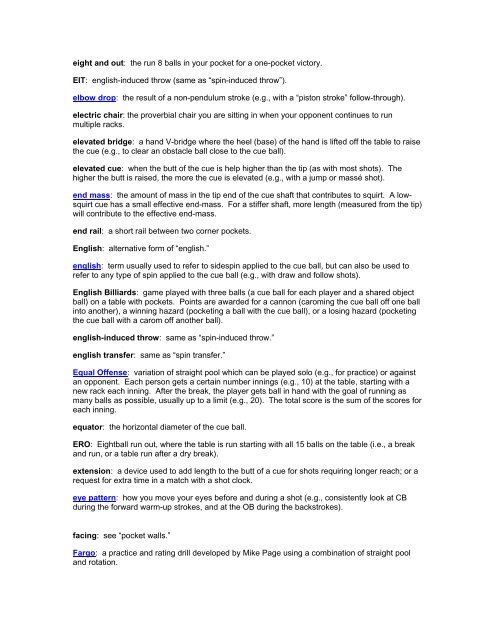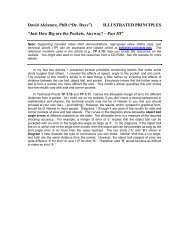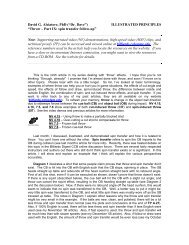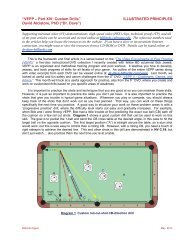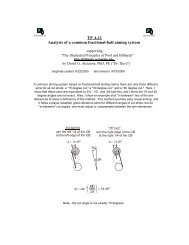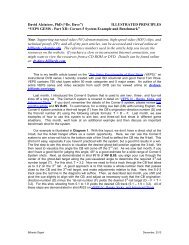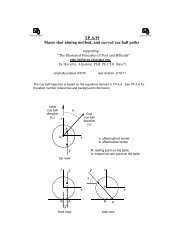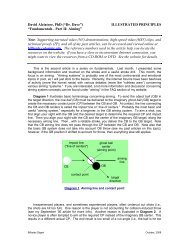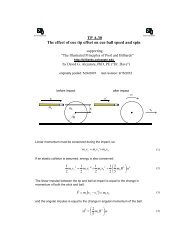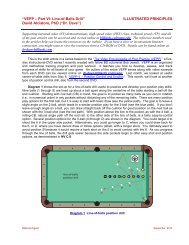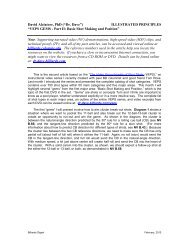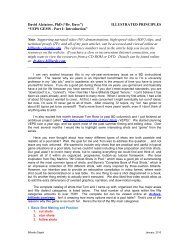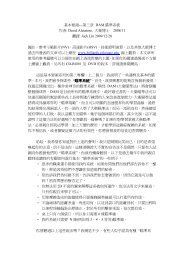Expanded Glossary from the book - Illustrated Principles of Pool and ...
Expanded Glossary from the book - Illustrated Principles of Pool and ...
Expanded Glossary from the book - Illustrated Principles of Pool and ...
Create successful ePaper yourself
Turn your PDF publications into a flip-book with our unique Google optimized e-Paper software.
eight <strong>and</strong> out: <strong>the</strong> run 8 balls in your pocket for a one-pocket victory.<br />
EIT: english-induced throw (same as “spin-induced throw”).<br />
elbow drop: <strong>the</strong> result <strong>of</strong> a non-pendulum stroke (e.g., with a “piston stroke” follow-through).<br />
electric chair: <strong>the</strong> proverbial chair you are sitting in when your opponent continues to run<br />
multiple racks.<br />
elevated bridge: a h<strong>and</strong> V-bridge where <strong>the</strong> heel (base) <strong>of</strong> <strong>the</strong> h<strong>and</strong> is lifted <strong>of</strong>f <strong>the</strong> table to raise<br />
<strong>the</strong> cue (e.g., to clear an obstacle ball close to <strong>the</strong> cue ball).<br />
elevated cue: when <strong>the</strong> butt <strong>of</strong> <strong>the</strong> cue is help higher than <strong>the</strong> tip (as with most shots). The<br />
higher <strong>the</strong> butt is raised, <strong>the</strong> more <strong>the</strong> cue is elevated (e.g., with a jump or massé shot).<br />
end mass: <strong>the</strong> amount <strong>of</strong> mass in <strong>the</strong> tip end <strong>of</strong> <strong>the</strong> cue shaft that contributes to squirt. A lowsquirt<br />
cue has a small effective end-mass. For a stiffer shaft, more length (measured <strong>from</strong> <strong>the</strong> tip)<br />
will contribute to <strong>the</strong> effective end-mass.<br />
end rail: a short rail between two corner pockets.<br />
English: alternative form <strong>of</strong> “english.”<br />
english: term usually used to refer to sidespin applied to <strong>the</strong> cue ball, but can also be used to<br />
refer to any type <strong>of</strong> spin applied to <strong>the</strong> cue ball (e.g., with draw <strong>and</strong> follow shots).<br />
English Billiards: game played with three balls (a cue ball for each player <strong>and</strong> a shared object<br />
ball) on a table with pockets. Points are awarded for a cannon (caroming <strong>the</strong> cue ball <strong>of</strong>f one ball<br />
into ano<strong>the</strong>r), a winning hazard (pocketing a ball with <strong>the</strong> cue ball), or a losing hazard (pocketing<br />
<strong>the</strong> cue ball with a carom <strong>of</strong>f ano<strong>the</strong>r ball).<br />
english-induced throw: same as “spin-induced throw.”<br />
english transfer: same as “spin transfer.”<br />
Equal Offense: variation <strong>of</strong> straight pool which can be played solo (e.g., for practice) or against<br />
an opponent. Each person gets a certain number innings (e.g., 10) at <strong>the</strong> table, starting with a<br />
new rack each inning. After <strong>the</strong> break, <strong>the</strong> player gets ball in h<strong>and</strong> with <strong>the</strong> goal <strong>of</strong> running as<br />
many balls as possible, usually up to a limit (e.g., 20). The total score is <strong>the</strong> sum <strong>of</strong> <strong>the</strong> scores for<br />
each inning.<br />
equator: <strong>the</strong> horizontal diameter <strong>of</strong> <strong>the</strong> cue ball.<br />
ERO: Eightball run out, where <strong>the</strong> table is run starting with all 15 balls on <strong>the</strong> table (i.e., a break<br />
<strong>and</strong> run, or a table run after a dry break).<br />
extension: a device used to add length to <strong>the</strong> butt <strong>of</strong> a cue for shots requiring longer reach; or a<br />
request for extra time in a match with a shot clock.<br />
eye pattern: how you move your eyes before <strong>and</strong> during a shot (e.g., consistently look at CB<br />
during <strong>the</strong> forward warm-up strokes, <strong>and</strong> at <strong>the</strong> OB during <strong>the</strong> backstrokes).<br />
facing: see “pocket walls.”<br />
Fargo: a practice <strong>and</strong> rating drill developed by Mike Page using a combination <strong>of</strong> straight pool<br />
<strong>and</strong> rotation.


